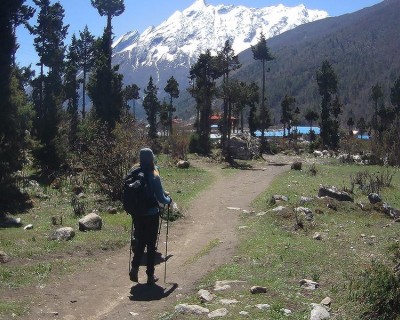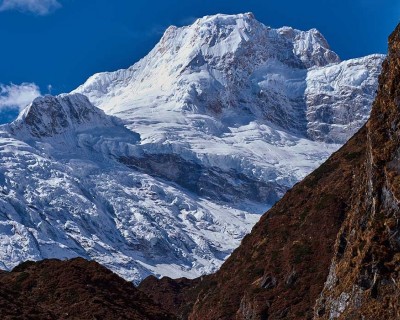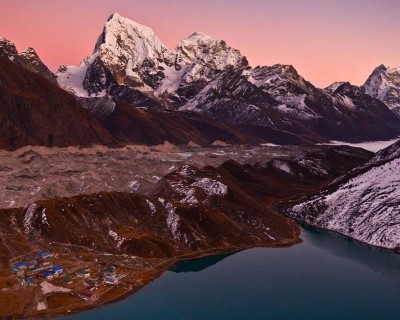Facts and Figures about Kanchenjunga Mountain
- Mt Kanchenjunga(8,586m)-The third highest peak in the world.
- Until 1852, Kanchenjunga was assumed to be the highest mountain in the world. Later, The Great Trigonometrical Survey concluded its Mt. Everest(8,884m) highest one.
- Least summited top after Mt. Annapurna (8,091 m).
- Other peaks like Kangchenjunga West(8,505m), Kanchenjunga Central(8,482m), Kanchenjunga South(8,494m).
- Kanchenjunga Conservation Area- The Second biggest conservation area of Nepal.
- Endangered wildlife such as Snow leopard, Musk deer, Red panda, etc.
- Globally significant plant species such as Rhododendrons and orchids.
- Traditional Nepali cultures- Rai, Limbu, and Magar Ethnics
- Remoteness and unexplored natural heritages.
- Globally significant plant species such as Rhododendrons and orchids.
- Different landscapes from meadows to snow hills.
- Astonishing views of Mt Everest, Mt Lhotse, and 14 other eastern Himalayas.
- Snow-capped mountains above 8000m.
- Kanchenjunga glacier and many others.
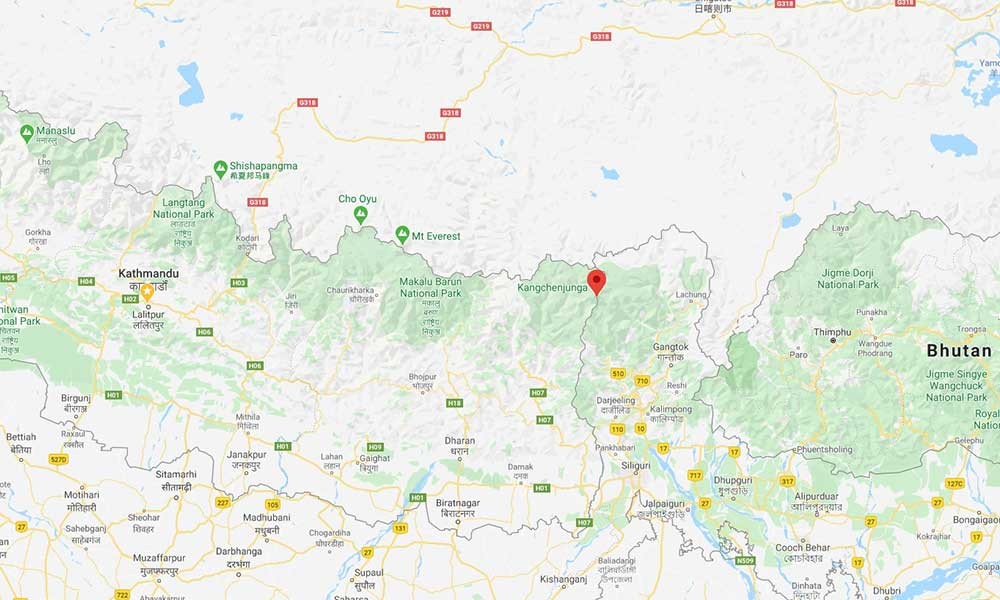
Where is Kanchenjunga Mountain Located
If you check the Kanchenjunga location on the map, the world’s third-highest mountain is located in eastern Nepal. Mt Kanchenjunga mountain’s location is shared by Nepal and India. Mt Kanchenjunga Main, Central, and South are shared by India and Nepal. While Mt Kanchenjunga West and Mt Kangbachen totally belong to Nepal’s Taplejung District. It lies about 125km southeast from mighty Mt. Everest. The main ridge of Kanchenjunga runs from northeast to southeast, later forming watersheds to rivers.
Kanchenjunga Base Camp Weather
The weather up in the mountains is quite unpredictable. There is no uniform weather even in the same season. As we go up the temperature and weather changes and vice versa. The temperature can go below -25 degrees Celcius in the upper altitudes. The temperature stays under minus degrees during the entire winter. Due to that, winter trek is so difficult.
Whereas in summer, this area gets regular rainfall. Such rainfall brings minus temperature in higher places, snowfalls, plus you have to walk through the routes that are muddy and slippery. Hence, it is not preferred by many visitors.
Best Time to Travel Mount Kanchenjunga Area
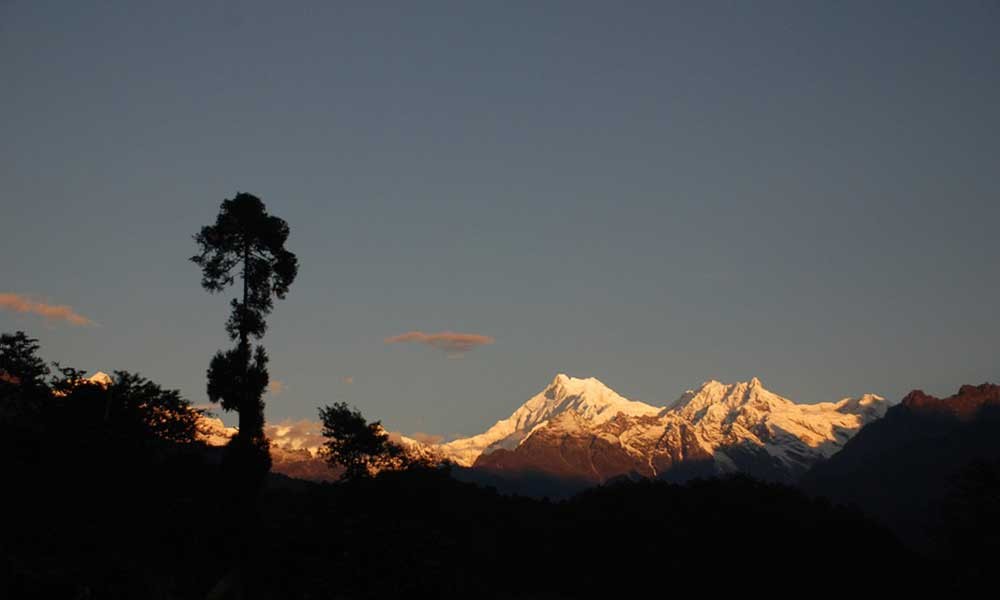
Autumn and Spring are the two most favorable periods to visit this place. During these seasons, the whole Kanchenjunga area is beautifully decorated by all means. The expectations of the trek will be over scored by reality.
Autumn( September- November)
Autumn is the best season to travel to this area. As the greenery of the forests is at the highest level. Colorful flowers offer you a pleasing smell along the trail. Throughout the season you can enjoy ecstatic views of mountains, blue sky, and green woodland.
Spring( March-May)
When winter leaves it also leaves a beautiful atmosphere in the palms of the Spring season.
There is an ambiance full of spectacular scenes of the mighty mountains and landscape. Several birds and animals can be watchful on some occasions.
On the other side, It is quite risky to travel during summer (June-August) as it is the rainy season in Nepal.
During the cold winter (December-February), the routes are covered with snow and the trek is extremely risky. Even so, some of the trekkers plan for Winter and Rainy seasons to add an extra adventure to their trip.
Flora and Fauna in Kanchenjunga Territory Trek
If still wondering, Where is Kanchenjunga mountain located? To answer that, It is in the vicinity of eastern Himalayas. And, the surrounding area is packed with a variety of vegetation and wildlife to every extent. The green hills are full of coniferous forests, grasslands, and meadows and inside there species of animals are surviving.
Kanchenjunga Conservation Area is a protected area in Lapse of Mt. Kanchenjunga. According to the World Wildlife Fund, The Kanchenjunga Conservation Area is a Global eco-region. So, it is famous for some rare species such as snow leopard, black bear, musk deer, red pheasant, etc. Hardly, Melanistic leopard, the high altitude living cat can also be seen.
Bird lovers may get to see the golden-breasted Fulvetta, snow cock and blood pheasant, and several others. Even if you are Anthophile, it's worthwhile where forests are inked by varieties of rhododendron, orchids and many other floras. Woods are overflowing with trees like Pine, Fir, Bamboo, and Hemlock in lower altitudes.
Cultures and Lifestyle of Kanchenjunga Area
People living in this area have a diverse cultural history. Experiencing their culture can be an experience of a lifetime. People do occupations like tourism, animal husbandry, and agriculture. You get to sample fresh and pure meals, too.
The main habitats of this region are from Rai, Sherpa, and Tamang communities. Monuments such as old Stupas, Bihar’s will guide visitors throughout the trails. Glancing at these heritage sites can trace you back to ancient civilization.
Kanchenjunga Climbing Routes
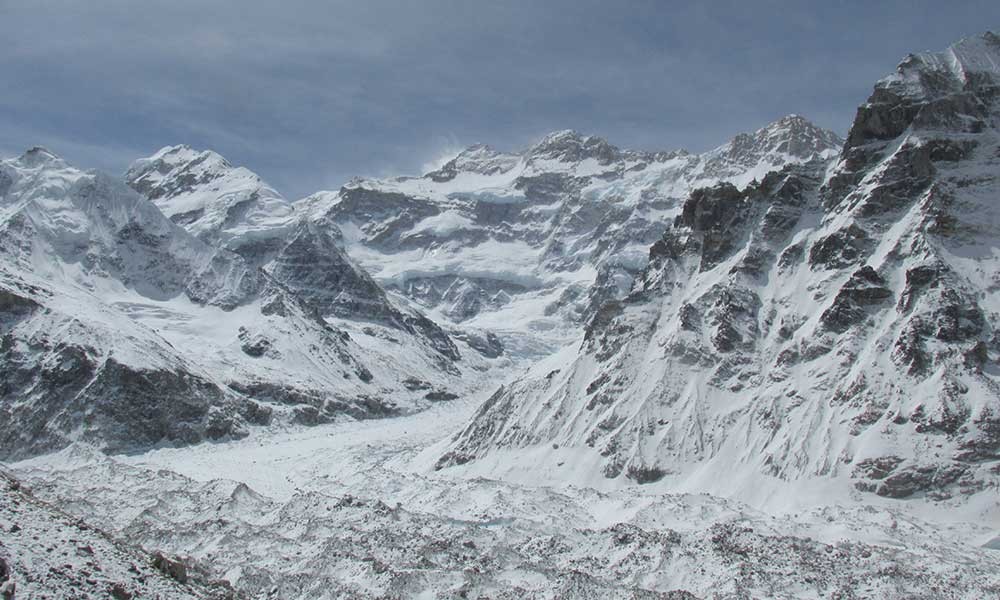
Mt. Kanchenjunga has four known scaling routes that are South-West, North-West, North-East, and North-Eastern. Of these, If you want to climb from Nepal the South-west, North-west and, North-east are the possible routes. The remaining one North-Eastern is from Sikkim, India. This route from Sikkim has been banned since 2000 by the Indian Government.
Among these, most of the trekkers pick North-west and South-west routes because they are safer than other routes. Yet, the trekkers should keep in mind that trails are not easy which combines high altitude, slippery ice, isolated areas, and sloppy hills.
If you want to reach the summit faster, either Kanchenjunga North Base Camp Trek or Kanchenjunga South Base Camp Trek are the best options. But, If you want to cover the wilderness of both routes, you will be adding days to your trip.
Kanchenjunga North Base Camp Trek
North Base Camp Trek presents you gorgeous views of snow-hatted mountains plus a tropical alpine forest stretched down in hills and picturesque glaciers. This area is also home to an abundant variety of wildlife including the frosty snow leopard, the Asian black bear, and red panda.
Birdwatchers also can encounter birds that they never have seen before like
Golden-breasted Fulvetta, Snowcock, and Blood pheasant. Also, You will spend some time with the Rai, Sherpa, and Tamang peoples of the region who have very amusing lifestyles.
Just as other Himalayan treks, this trek will also demand you to be physically fit and fine. To reach base camp you have to pass through Kanchenjunga glacier. After that tough climb, you will finally reach Pangpema (5,100m), your final point of uphill. Positioned above the glacier, the view from there is a mouth opening. The base camp offers an irresistible view of Kanchenjunga West(8,505m). As well as, you will spend time with the Rai, Sherpa, and Tamang people of the region who have a direct influence on the Tibetan lifestyles.
Itinerary for Kanchenjunga North Base Camp Trek
Day 1: Flight from Kathmandu to Bhadrapur (45 minutes approx.)
Day 2: Bus from Birtamod to Taplejung on a local bus (8-10 hours approx.)
Day 3: Finally, your trek will kick-off. Trek starts from Taplejung to Chiruwa
(6-7 hours approx.)
Day 4: From Chiruwa, you will trek to Lelep (1860m);7hr.
Day 5: Trek from Lelep to Amjilosa( 2,510m); 8-9 hr.
Day 6: Walk from Amjilosa to Gyabla(2,730m); 4hr.
Day 7: Trek from Gyabla to Gunsa (3,595m); 4hr.
Day 8: Acclimatization day in Ghunsa (3,475m); 7hr.
Day 9: Trek from Ghunsa to Kambachen ( 4,100m); 4hr.
Day 10: You can acclimatize in this Kambachen for the day; 8hr.
Day 11: You need to trek a high altitude from Kambachen to Lhonak (around 4790m); 4hr.
Day 12: Trek from Lhonak to Pangpema (5140m);9-10hrs.
Day 13: Trek back from Lhonak to Ghunsa; 6 hr.
Day 14: Trek back from Ghunsa to Amjilosa; 7-8 hr.
Day 15: Trek back from Amjilosa to Tapethok; 6-7 hrs.
Day 16: Trek back from Tapethok to Mitlung;7 hr.
Day 17: Arrive at Taplejung; 4-5 hr
Day 18: A bus ride from Taplejung to Birtamod; 8-10 hrs.
Day 19: You can reach Bhadrapur by private jeep ride of 40 minutes and fly back to the capital.
Few Helpful articles you may also like:
Kanchenjunga South Base Camp Trek
It is an easier route in comparison to Kanchenjunga North Base Camp. The trails to this base camp are a little bit easy-breezy. But the views and surroundings of this area are hard to digest, it's all heavenly. You will crossway through Kanchenjunga Conservation Area, if lucky enough you may encounter Snow Leopard and other habitats. Jointly, you can walk through the alluring routes filled with alpine trees, rhododendrons, and orchids.
Other than that, this route will share with you a closer view of tribals living around here. Rai, Sherpa, Limbu, and Tamang are the major natives of this region. You can get enlightened by their cultures, living styles, and traditions.
You will have to cross the beautiful Yalung Glacier before reaching Ramche (4,610m). From Ramche you can nab the beautiful views of Mt Kanchenjunga South, Mt Janu, Mt Nyukla and other wow-feeling Himalayan peaks. If you have strong fitness, desire to walk, and curiosity in nature, this is a perfect trek.
Itinerary for Kanchenjunga South Base Camp Trek
Day 1: Flight from Kathmandu to Bhadrapur (45 minutes approx.)
Day 2: Bus from Birtamod to Taplejung; 8-10 hr.
Day 3:Trek begins from Taplejung to Lali Kharkha(1880m); 6hr.
Day 4: Trek from Lali Kharkha to Khesewa (1960m approx); 5-6hr.
Day 5: Trek from Khesewa to Phumpe Danda (1786m); 6hr.
Day 6: Trek from Phumpe Danda to Yamphuding (1650m approx); 6hr.
Day 7:Yamphuding to Torongding(2340m); 6hr.
Day 8: Trek from Torongding to Cheram (3868m);5-6hrs.
Day 9: Trek from Cheram to Ramche (4600m).It will take 3 hours from Cheram. To reach the South base camp, you need to hike 2 hours from Ramche.
Day 10: Trek back from Ramche to Torongding (6-7 hrs).
Day 11: Trek back from Torongding to Yamphuding (5-6 hrs).
Day 12: Trek back from Yamphuding to Khebang (5-6 hrs).
Day 13: Trek back to Khebang to Kamdime (6-7 hrs).
Day 14: You can drive back to Birtamod. It will take 14 hours to reach Birtamod.
Day 15: You can drive back to Bhadrapur for a 40-minute drive and then take a flight back to Kathmandu.
Trekking Equipment Checklist
The following is the list of equipment that you must have in your travel bag.
For Head
- Sun hat or scarf
- Sunglasses
- Headlight
- Sun cream
- Lip guard
For Upper body
- T-shirt: half/full
- Fleece jacket
- Water poncho/ raincoat
- Down jacket, wind/waterproof jacket
For Lower body
For Feet
- Thin/thick and woolen each pair of socks
- Strong trekking boots
- Extra shoes or sandals
For Hand
For Accessories
- Each Sleeping bag, – 20-degree celsius
- Trekking bag/ day bag and duffle bag
- Trekking/hiking poles
- Water bottle or camel bag
- Toilet rolls/tissue paper
- Books/ playing cards for killing times
Trekking Eligibility
Firstly, Trekkers should have an acceptable Passport and Visa to get into the country. Plus there is a specific rule set by the Government, you cannot travel on your own. Kanchenjunga Base Camp Trek routes are not as developed as the most popular Annapurna Base Camp Trek or Everest Base Camp Trek. The trekkers should be in a group of at least two persons and they have to be guided by an authorized trekking company.
Permits to Get for Kanchenjunga Circuit Trek
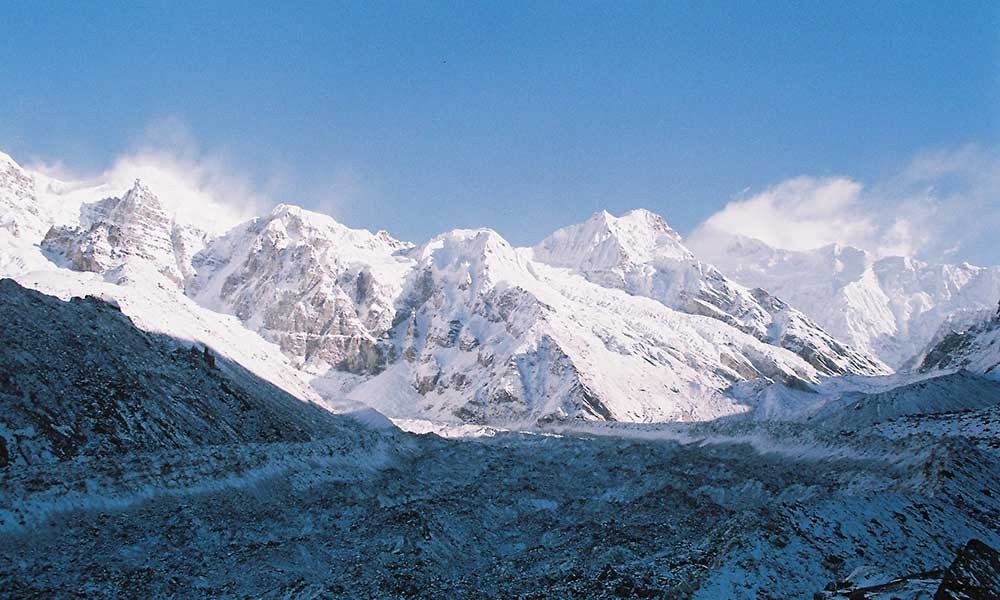
Trekkers need two special permits to join the Kanchenjunga Circuit. An authorized trekking company should be hired for getting a permit. Nepal Tourism Board governs such permits.
Kanchenjunga Restricted Area Entry Permit
Olangchungola village, Lelep village, Papung village, and Yamphuding village are the five restricted villages of the Kanchenjunga area. Hence, a special entry permit is required to enter these villages which cost around USD 10 per person per week.
Kanchenjunga Conservation Area Entry Permit(KCAEP)
Kanchenjunga Conservation Area is a protected area in the eastern Himalayas. And, this zone is home to several endangered flora and fauna. So, there is a fee of NRS 2000 per person for an entry permit which is valid for 30 days.
If you have further queries or you seek travel-related information, please feel free to contact us.
Other Restricted Region Trekkings you may like:






